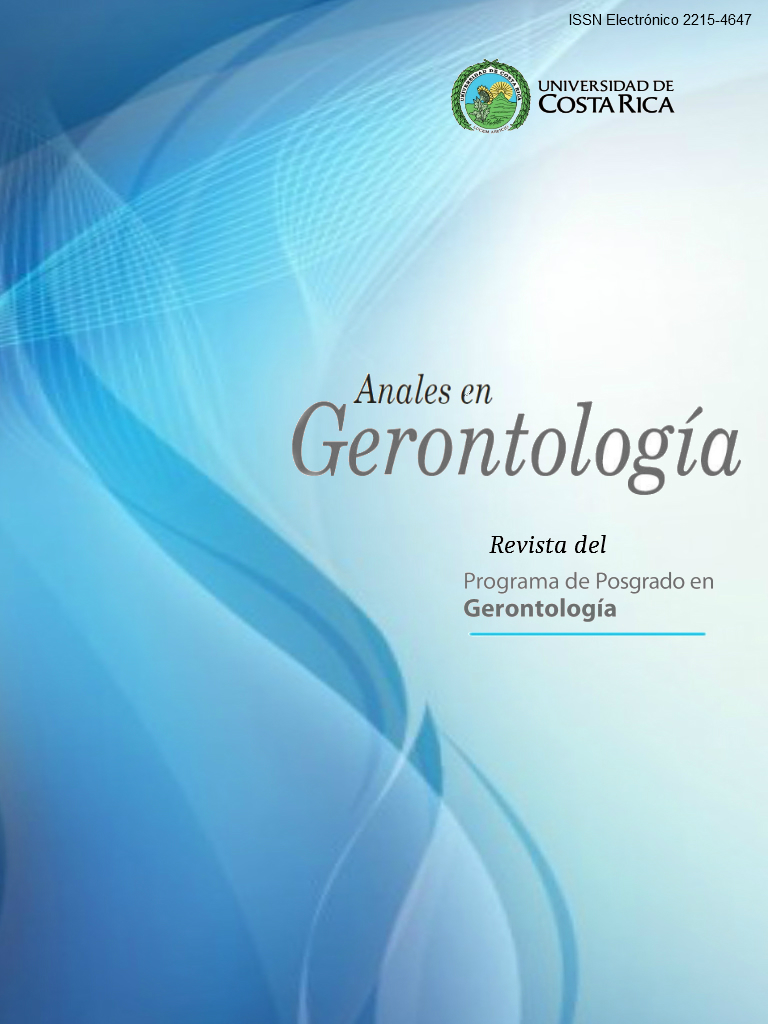Resumen
El dolor crónico (DC) es un problema significativo para las personas adultas mayores (PAM), convencionalmente, se le trata a base de fármacos los cuales no siempre logran aliviarlo, por lo que existe necesidad de un abordaje no farmacológico, efectivo y más económico. En este ensayo científico se presenta un panorama del DC en PAM y su tratamiento desde esta perspectiva, en la cual se incluyen técnicas psicológicas como la respiración diafragmática, la relajación muscular progresiva, la revelación emocional, la imaginación guiada, y la hipnosis; usadas frecuentemente en combinación con otras terapias no convencionales como la herbolaria, quiropráctica, masajes y suplementos alimenticios, con el afán de complementar el tratamiento médico convencional e incluso en lugar de este. Las personas profesionales en gerontología deben conocerlos y considerar que estas terapias son ampliamente aceptadas por muchas PAM. El aporte metodológico de este ensayo radica en que informa sobre opciones de tratamiento para un problema de salud pública mundial que, desgraciadamente, continúa en crecimiento.
Citas
Booker, S. & Herr, K. (2021). Voices of African American Older Adults on the Implications of Social and Healthcare-Related Policies for Osteoarthritis Pain Care. Pain Management Nursing, 22(1), 50–57. https://doi.org/10.1016/j.pmn.2020.09.001
Booker, S. Q., Herr, K. A. & Horgas, A. L. (2021). A Paradigm Shift for Movement-based Pain Assessment in Older Adults: Practice, Policy and Regulatory Drivers. Pain Management Nursing, 22(1), 21–27. https://doi.org/10.1016/j.pmn.2020.08.003
Cherkin, D. C., Sherman, K. J., Balderson, B. H., Cook, A. J., Anderson, M. L., Hawkes, R. J., Hansen, K. E. & Turner, J. A. (2016). Effect of mindfulness-based stress reduction vs cognitive behavioral therapy or usual care on back pain and functional limitations in adults with chronic low back pain: A randomized clinical trial. JAMA - Journal of the American Medical Association, 315(12), 1240–1249. https://doi.org/10.1001/jama.2016.2323
Cohen, S. P., Bhatia, A., Buvanendran, A., Schwenk, E. S., Wasan, A. D., Hurley, R. W., Viscusi, E. R., Narouze, S., Davis, F. N., Ritchie, E. C., Lubenow, T. R. & Hooten, W. M. (2018). Consensus Guidelines on the Use of Intravenous Ketamine Infusions for Chronic Pain From the American Society of Regional Anesthesia and Pain Medicine, the American Academy of Pain Medicine, and the American Society of Anesthesiologists. Regional Anesthesia and Pain Medicine, 43(5), 521–546. https://doi.org/10.1097/AAP.0000000000000808
Domenichiello, A. F. & Ramsden, C. E. (2019). The silent epidemic of chronic pain in older adults. Progress in Neuro-Psychopharmacology and Biological Psychiatry, 93, 284–290. https://doi.org/10.1016/j.pnpbp.2019.04.006
Gebauer, S., Schootman, M., Xian, H. & Xaverius, P. (2020). Neighborhood built and social environment and meeting physical activity recommendations among mid to older adults with joint pain. Preventive Medicine Reports, 18, 101063. https://doi.org/10.1016/j.pmedr.2020.101063
Mills, S. E. E., Nicolson, K. P. & Smith, B. H. (2019). Chronic pain: a review of its epidemiology and associated factors in population-based studies. British Journal of Anaesthesia, 123(2), e273–e283. https://doi.org/10.1016/j.bja.2019.03.023
Musich, S., Wang, S. S., Slindee, L., Kraemer, S. & Yeh, C. S. (2020). The association of pain locus of control with pain outcomes among older adults. Geriatric Nursing, 41(5), 521–529. https://doi.org/10.1016/j.gerinurse.2019.04.005
Ruvalcaba Palacios, G. y Galván Guerra, A. (2017). Manual de capacitación en el uso de la retroalimentación biológica para el desarrollo de investigación clínica. Sello Editorial Comfenalco (Primera). Cartagena de Indias, Colombia.
Schumann, M. E., Lapid, M. I., Cunningham, J. L., Schluenz, L. & Gilliam, W. P. (2020). Treatment Effectiveness and Medication Use Reduction for Older Adults in Interdisciplinary Pain Rehabilitation. Mayo Clinic Proceedings: Innovations, Quality & Outcomes, 4(3), 276–286. https://doi.org/10.1016/j.mayocpiqo.2020.01.004
Schwan, J., Sclafani, J. & Tawfik, V. L. (2018). Chronic pain management in the elderly. Physiology & Behavior, 176(1), 139–148. https://doi.org/10.1016/j.anclin.2019.04.012.Chronic
Tang, S. K., Tse, M. M. Y., Leung, S. F. & Fotis, T. (2019). The effectiveness, suitability, and sustainability of non-pharmacological methods of managing pain in community-dwelling older adults: A systematic review. BMC Public Health, 19(1), 1–10. https://doi.org/10.1186/s12889-019-7831-9
Vespa, J. (2018). The graying of America: More older adults than kids by 2035. United States Census Bureau. https://www.census.gov/library/stories/2018/03/graying-america.html
Vrdoljak, D. & Borovac, J. A. nđel. (2015). Medication in the elderly - considerations and therapy prescription guidelines. Acta Medica Academica, 44(2), 159–168. https://doi.org/10.5644/ama2006-124.142
Wackström, N., Koponen, A. M., Suominen, S., Tarkka, I. M. & Simonsen, N. (2020). Does chronic pain hinder physical activity among older adults with type 2 diabetes? Health Psychology and Behavioral Medicine, 8(1), 362–382. https://doi.org/10.1080/21642850.2020.1807350
Welsh, T. P., Yang, A. E. & Makris, U. E. (2020). Musculoskeletal Pain in Older Adults: A Clinical Review. Medical Clinics of North America, 104(5), 855–872. https://doi.org/10.1016/j.mcna.2020.05.002
Whibley, D., Braley, T. J., Kratz, A. L. & Murphy, S. L. (2019). Transient Effects of Sleep on Next-Day Pain and Fatigue in Older Adults With Symptomatic Osteoarthritis. Journal of Pain, 20(11), 1373–1382. https://doi.org/10.1016/j.jpain.2019.04.011
Zis, P., Daskalaki, A., Bountouni, I., Sykioti, P., Varrassi, G. & Paladini, A. (2017). Depression and chronic pain in the elderly: Links and management challenges. Clinical Interventions in Aging, 12, 709–720. https://doi.org/10.2147/CIA.S113576
##plugins.facebook.comentarios##

Esta obra está bajo una licencia internacional Creative Commons Atribución-NoComercial-SinDerivadas 4.0.
Derechos de autor 2022 Anales en Gerontología

